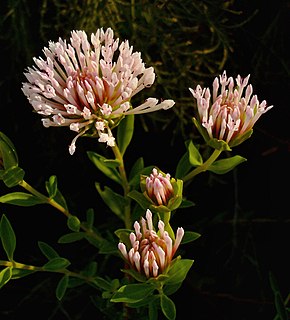
Pimelea calcicola is a species of flowering plant in the family Thymelaeaceae and is endemic to part of the west coast of Western Australia. It is an erect to spreading shrub with elliptic leaves arranged in opposite pairs, and head-like racemes of pale to deep pink, tube-shaped flowers surrounded by leaf-like involucral bracts.

Pimelea ferruginea, commonly known as pink rice flower or coastal banjine, is a species of flowering plant in the family Thymelaeaceae and is endemic to near-coastal areas of south-western Western Australia. It is a dense, erect shrub with elliptic to narrowly elliptic leaves and head-like clusters of pale to deep pink, tube-shaped flowers.
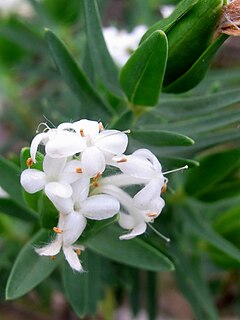
Pimelea congesta is a species of flowering plant in the family Thymelaeaceae and is endemic to Lord Howe Island in Australia. It is a shrub with rough bark, decussate, elliptic leaves and heads of white flowers.
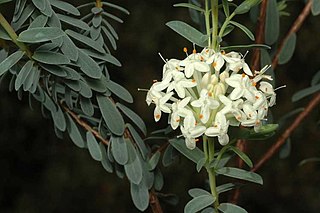
Pimelea ciliolaris is a species of flowering plant in the family Thymelaeaceae and is endemic to a restricted area of New South Wales. It is a stunted shrub with narrowly elliptic leaves and heads of densely hairy, cream-coloured to pale yellow flowers.

Pimelea curviflora, also known as curved rice-flower, is a shrub in the family Thymelaeaceae and is endemic to Australia. It is a small, hairy shrub with greenish-yellow or red tubular flowers.
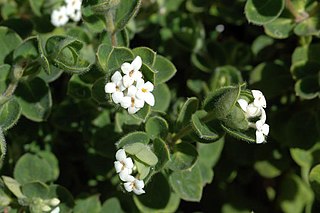
Pimelea altior is a species of flowering plant in the family Thymelaeaceae and is endemic to eastern Australia. It is a shrub with elliptic leaves and heads of white, tube-shaped flowers.
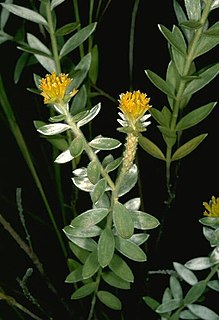
Pimelea amabilis is a species of flowering plant in the family Thymelaeaceae and is endemic to northern Queensland. It is a small shrub with narrowly elliptic or elliptic leaves and spikes of hairy, yellowy-green or yellow, tube-shaped flowers.
Pimelea approximans is a species of flowering plant in the family Thymelaeaceae and is endemic to northern Queensland. It is a perennial shrub with elliptic leaves and spikes of hairy, yellow, tube-shaped flowers.
Pimelea aquilonia is a species of flowering plant in the family Thymelaeaceae and is endemic to far north Queensland. It is a shrub with narrowly elliptic leaves and small clusters of hairy, white or cream-coloured, tube-shaped flowers.

Pimelea argentea, commonly known as silvery leaved pimelea, is a species of flowering plant in the family Thymelaeaceae and is endemic to the south-west of Western Australia. It is an erect shrub with densely hairy young stems and leaves, the leaves linear to elliptic, and heads of white to yellow or greenish flowers, the male and female flowers on separate plants.
Pimelea biflora, commonly known as matted rice-flower, is a species of flowering plant in the family Thymelaeaceae and is endemic to south-eastern continental Australia. It is a prostrate, mat-forming shrub with elliptic leaves and dark red flowers always arranged in pairs on the ends of branches.

Pimelea bracteata, is a species of flowering plant in the family Thymelaeaceae and is endemic to the south-west of New South Wales. It is a shrub with narrowly egg-shaped to elliptic leaves and pendulous, pale green heads of pale yellow flowers.
Pimelea chlorina is a species of flowering plant in the family Thymelaeaceae and is endemic to north Queensland. It is a shrub with silvery, elliptic or egg-shaped leaves and clusters of greenish-yellow, tube-shaped flowers.
Pimelea clavata is a species of flowering plant in the family Thymelaeaceae and is endemic to near-coastal areas and offshore islands of southern Western Australia. It is an erect shrub with narrowly elliptic to more or less linear leaves arranged in opposite pairs, and head-like clusters of white to pale yellow, tube-shaped flowers surrounded by leaf-like involucral bracts.

Pimelea cracens is a species of flowering plant in the family Thymelaeaceae and is endemic to the southwest of Western Australia. It is an erect, spindly shrub with narrowly elliptic to egg-shaped leaves and creamy green to pale yellow flowers surrounded by 6 or 8 yellowish or pale green and reddish involucral bracts.

Pimelea trichostachya, commonly known as annual riceflower, spiked riceflower or flax weed, is a species of flowering plant in the family Thymelaeaceae and is endemic to continental Australia. It is a slender, semi-woody, annual shrub with narrowly elliptic or linear leaves and densely hairy, white or yellow flowers and green, purple-tinged fruit. It is toxic to livestock.
Pimelea elongata is a species of flowering plant in the family Thymelaeaceae and is endemic to inland areas of eastern Australia. It is a slender forb with linear to narrowly elliptic leaves and spikes of hairy, yellowish-green flowers.
Pimelea erecta is a species of flowering plant in the family Thymelaeaceae and is endemic to the southwest of Western Australia. It is an erect, often spreading shrub with elliptic to egg-shaped leaves arranged in opposite pairs, and clusters of erect, white or pale pink flowers.
Pimelea eyrei is a species of flowering plant in the family Thymelaeaceae and is endemic to the southwest of Western Australia. It is an erect shrub with hairy, narrowly elliptic leaves and clusters of densely hairy, white or cream-coloured flowers.
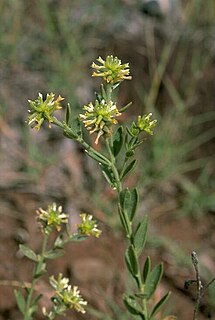
Pimelea confertiflora is a species of flowering plant in the family Thymelaeaceae and is endemic to north Queensland. It is a shrub with densely hairy young stems, elliptic or narrowly elliptic leaves and spikes of yellowish-green or yellow, tube-shaped flowers.











